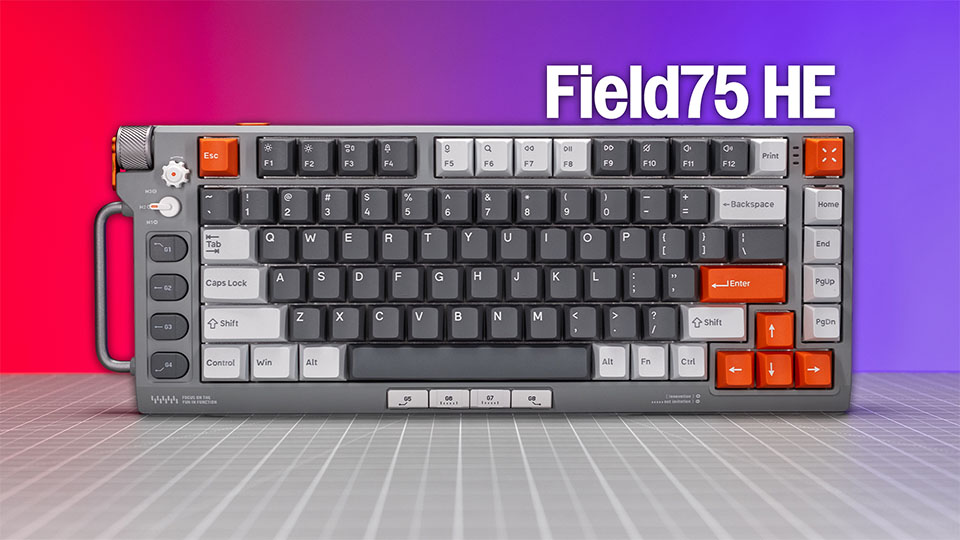Links in this post may be affiliate links. Any products purchased through affiliate links may provide a small commission which helps to support the SemiPro Tech+Gear site and YouTube channel.
NuPhy has stepped into the hall effect keyboard market with the Field75 HE. With impressive performance specs, it promises to be a top performer for competitive gamers. But is it also a comfortable daily driver?
The Field75 HE takes the original Field75 design, adds hall effect switches and improved performance, and ditches the wireless connectivity in favor of a wired connection with up to 8,000Hz polling for ultra-low latency. They’ve also created a new customization experience with NuPhy IO, a web-based app compatible with Windows, Mac, and Linux, brining remapping and multiple functions that are unique to hall effect switches. At a price lower than several top-tier gaming keyboards from the likes of Razer and ASUS, NuPhy has put together a very interesting package.
NuPhy Field75 HE
MSRP: $149.95 ($174.95 with Jade switches)
Pros
- Excellent raw gaming performance (sub-1ms latency)
- Super-customizable functions including dynamic keystrokes
- 8 extra custom buttons
- Three customizable on-board modes/profiles
- Simple to use customization software
Cons
- Daily typing feel suffers a bit (very firm)
- Sound is nothing special (vs. NuPhy’s other keyboards)
- Plastic build is a little lackluster at this price
- No macro capability at the time of writing
Best For: When you want top-tier gaming performance with advanced customization and unique design.
Use code SEMIPRO for $10 off $100+ at NuPhy!
Features and Specifications
The Field75 HE is not short on features, but some may seem a bit advanced if you’ve not done much software-based keyboard customization in the past. We’ll get to that in a moment, first we need to discuss the construction, performance, and typing experience.
Construction & Design
The case construction is ABS plastic – which feels less than premium at this price point, but that does not mean the Field75 HE feels “cheap”. It does not, however I personally would like to see some higher-end materials in a keyboard with a price above $150. If you’re purely after a keyboard with the best raw performance though, you may be willing to overlook the all-plastic construction.
NuPhy went all-in on maximizing accuracy of capturing & measuring your inputs here. When it comes to accuracy of measuring key strokes, softness and flexibility is the enemy. Elements that contribute to a soft feel and flexibility, such as a squishy gasket mount or flexible polycarbonate plate, allow some of your typing force to be displaced away from downward key movement. The up & down movement of the PCB & plate assembly can also result in minute inaccuracies in measuring key travel – we’re talking fractions of a millimeter. Since the actuation point of the hall-effect switches in the Field75 HE are adjustable down to 0.1mm increments, NuPhy opted to ditch anything soft or flexible here and went with an aluminum plate and top mount. This helps to prevent funky behavior from the switches and results in a firm typing feel.
The sound and feel both suffer a bit from this “all-in on performance” approach, at least in my opinion. The feel is firm, and the sound is nothing special – meaning it sounds like many other all-plastic keyboards at lower price points. The Jade switches help the sound a bit, but in terms of using the Field75 HE as a daily productivity keyboard aside from gaming use, it wouldn’t be my favorite. NuPhy’s Halo75 V2 would be my pick for a daily driver, however I recognize that is very subjective and some may enjoy the feel and sound just fine. The video above includes a sound test so be sure to check that out.
With regard to the design of the Field75 HE, let’s be honest, this is a niche keyboard. That’s not a bad thing, but it’s not going to be everyone’s cup of tea. Design is very subjective, but for the purpose of my review it’s just worth noting that the design of this keyboard is not what you would call “traditional”. Besides the 75% layout, there are 8 additional custom buttons on the left side and below the spacebar, as well as a volume roller and dials for changing the mode and backlight settings.
Connectivity & Performance
Connectivity is pretty straightforward – it’s USB-C wired only. There are no wireless connections available, however that’s not uncommon for HE keyboards. There currently are not many wireless HE keyboards on the market (the Keychron Q1 HE is one), and sticking with a wired connection ensures you get the maximum 8k polling rate with no interruptions.
The raw performance is impressive. NuPhy included a high-performance MCU with 8,000Hz scan rate to provide support for the 8k polling rate – this means there is no “bottleneck” for the polling rate. Latency is a way to measure the time it takes a keystroke to actually reach your computer and be recognized – measuring what is being received vs. measuring what the keyboard is sending.
NuPhy’s stated latency figure for the Field75 HE is 0.5ms, which is very low…like really, super low. Gaming keyboards typically aim for the lowest possible latency for obvious reasons – you want your inputs to trigger actions in-game as quickly as possible. Many popular gaming keyboards (non HE) achieve a latency figure of 1-3ms over wired or 2.4GHz connections, like the ASUS ROG Azoth ($249 MSRP) which provides a wired latency of 2.7ms according to rtings.com. The Field75 HE was also tested by rtings.com with a single-key result of 0.8ms, just 0.3ms slower than NuPhy’s stated figure.
The bottom line for the Field75 HE is that the gaming performance is fantastic. It’s not just the best-performing keyboard NuPhy has made from a latency standpoint, it’s now one of the best on the market.
Backlighting
Backlighting is per-key RGB however it is south-facing. For custom keyboards this typically is a non-issue and this position avoids any potential keycap/switch contact in the very low row 3 of cherry profile keycaps. However gaming keyboards often include shine-through keycaps for low-light visibility, and north-facing backlight is best for this because keycaps often have legends towards the top of the keycap, not the bottom. The Field75 HE does not come with shine-through keycaps, so if you want to add shine-through keycaps yourself you’ll want to make sure they do not have legends in the top corner because the lights won’t illuminate them well. Front-facing side legends would be the best option, though not everyone loves side legends (me included).
Switch Options & Keycaps
Switch options are pretty simple here – NuPhy offers two magnetic switches from Gateron in the Field75 HE. At the base MSRP of $149.95 we have Gateron KS20 white switches, and for the higher price of $174.95 you can opt for Gateron Jade switches. They both have 30g actuation force, but the white switches have 4mm of total travel and a 15mm spring while Jade switches have 3.3mm travel and a 20mm spring. I’ve tested both of these switches, and I can tell you that the Jade switches have a snappier feel and a sound profile that I prefer over the white switches (see the video above for a sound test).
The keycaps are cherry profile, double-shot PBT. They have a nice feel and overall are good quality, but as I mentioned above they are not shine-through, so that may be less appealing for gamers who are used to shine-through keycaps for good low-light visibility.
Customization
NuPhy opted for a web-based customization tool with the Field75 HE rather than standalone software that has to be downloaded and installed, and I applaud this decision. The NuPhy.io web app works on windows, mac, and linux, and I far prefer using a web-based tool because I can access it on any machine the keyboard is connected to.
There are three on-board profiles that can be customized. By default the profiles are set up as windows, mac, and gaming modes, but all of them can be fully customized and you can even re-name the modes. Customization options include traditional remapping of a few layers within each mode and adjusting the backlight settings. And then comes the HE customization – this is where things may get a little overwhelming to a hall-effect newbie, even from a terminology standpoint. The first adjustment to pay attention to is the actuation point, which determines how far you have to press a key before it triggers an input. By default they are set in the middle of the switch travel, which is fine for everyday use. Setting it lower means you have to use more force, which can be fatiguing over long periods. Setting it very high up can be better for gaming, but will lead to more mistakes when responding to those emails because even the slightest graze of a key registers an input. This is where different profiles come in handy – you can customize one for gaming and one for general typing.
Next to your actuation point setting is the option for rapid trigger and setting the reset point. The reset point determines how far the switch needs to return/rebound before another entry will register on the same key. Gamers generally like to have the same actuation & reset point because it means rapid-fire entries all register properly, vs. having a reset point that’s higher up than the actuation point which means you can’t repeatedly press the same key as quickly. Feeling overwhelmed yet? I hope not because we’ve only scratched the surface.
I won’t go into granular detail about all of the customization options here or this article will be longer than a Tolkien novel. There are multiple other options to customize your inputs, including dynamic keystrokes which allows you to set multiple entries for a single key based on the travel distance – basically you can have a string of entries occur in succession at different actuation points. There are also rapid-shift and SOCD options, and these are getting into how your keyboard behaves when multiple keys are pressed in rapid succession or at the same time.
The one glaring omission, which NuPhy has stated they are working on, is macros. NuPhy.io does not support macros at the time of this writing, which is a bummer. Hopefully the wait is not long for this, because at the moment it means those 8 extra custom buttons cannot be macro keys, so things as simple as “CTRL+ALT+DEL” cannot be assigned to these buttons (and no, dynamic keystroke is not a macro replacement because the entries are not captured concurrently).
Ultimately, the Field75 HE provides all the hall-effect customization that competitors like Wooting offer and NuPhy.io makes it fairly simple.
Is it Worth It?
So who is the Field75 HE for? For many other keyboards the answer to that question can be complex, but NuPhy made this very simple. They put gaming performance on top of the priority list and delivered. The extremely low latency and customization options make the Field75 HE a top choice for gamers, as long as the design appeals to you.
But for everyone else, meaning those of us who spend more time (or all of our time) using keyboards for general productivity work, writing, coding, content creation, etc. the Field75 HE is sort of an unnecessary tool for the job unless this particular keyboard just speaks to you. I personally would look to options like the Halo75 V2 if gaming performance is not your number-one priority. You can still game with the Halo75 V2 thanks to its 1,000Hz polling rate, but it has a softer feel and more switch options to get the sound that’s just right for you.
Check out the Field75 HE
Keyboard Specs:
Price: $149.95 (Gateron white switches) / $174.95 (Gateron Jade switches)
Layout: ANSI 75% | 83 keys + volume roller and 8 custom buttons
Switch Options: Gateron HE white, Gateron HE Jade
Hot-swappable: Yes (HE switches only)
Connectivity: Wired only (8,000Hz)
OS Compatibility: mac/windows/linux
Typing angle: 4º/9º
Frame: ABS
Bottom case: ABS
Keycap: PBT, double shot, cherry profile
Dimensions: 372.3 x 142.8mm
Front Height: 21mm
Rear Height: 40.4mm
Weight: 1205g / 2.66lbs


